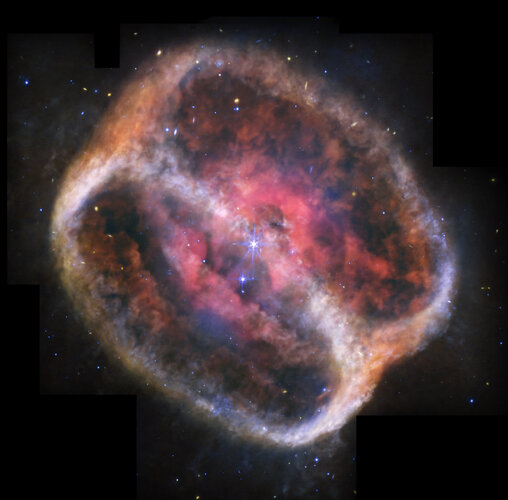
Copernical Team
Blue Skies Space to Design CubeSat Constellation for Lunar-Based Cosmology Research
 Blue Skies Space has secured funding from the Italian Space Agency (ASI) to explore the design of a CubeSat-based satellite constellation capable of orbiting the Moon and conducting observations of the early universe.
The initiative, known as RadioLuna, will assess whether a network of compact satellites placed in lunar orbit could detect the elusive radio emissions from the universe's for
Blue Skies Space has secured funding from the Italian Space Agency (ASI) to explore the design of a CubeSat-based satellite constellation capable of orbiting the Moon and conducting observations of the early universe.
The initiative, known as RadioLuna, will assess whether a network of compact satellites placed in lunar orbit could detect the elusive radio emissions from the universe's for Beyond Gravity and Rocket Lab join forces to streamline satellite constellation deployment
 Beyond Gravity and Rocket Lab have announced a strategic partnership to deliver an integrated avionics and software solution designed to accelerate satellite constellation missions. The collaboration merges Beyond Gravity's high-volume constellation On Board Computer (cOBC) with Rocket Lab's advanced MAX Constellation flight software and InterMission ground operations suite, offering a ready-to-
Beyond Gravity and Rocket Lab have announced a strategic partnership to deliver an integrated avionics and software solution designed to accelerate satellite constellation missions. The collaboration merges Beyond Gravity's high-volume constellation On Board Computer (cOBC) with Rocket Lab's advanced MAX Constellation flight software and InterMission ground operations suite, offering a ready-to- Hera's Mars flyby - Asteroid Framing Camera (colourised)
 Video:
00:02:14
Video:
00:02:14
On 12 March 2025, ESA’s Hera spacecraft soared just 5000 km above Mars and passed within 300 km of its distant moon, Deimos. Captured by Hera’s 1020x1020 pixel Asteroid Framing Camera, this video sequence offers a rare view of the red planet and its enigmatic moon. The original greyscale images have been colour-enhanced based on known surface features.
Maryland lawmakers say Trump cuts to NASA Goddard could slash US space programs in half
This request seems a bit unusual, so we need to confirm that you're human. Please press and hold the button until it turns completely green. Thank you for your cooperation!
Press and hold the button
If you believe this is an error, please contact our support team.
185.132.36.159 : 170846b7-6e99-4ab6-96d1-6f38b734
Blue Origin launches an all-female celebrity crew with Katy Perry, Gayle King and Lauren Sanchez
This request seems a bit unusual, so we need to confirm that you're human. Please press and hold the button until it turns completely green. Thank you for your cooperation!
Press and hold the button
If you believe this is an error, please contact our support team.
185.132.36.159 : 4b76a101-6644-487d-a43c-dbd35220
NASA's IMAP arrives at NASA Marshall for testing in XRCF
This request seems a bit unusual, so we need to confirm that you're human. Please press and hold the button until it turns completely green. Thank you for your cooperation!
Press and hold the button
If you believe this is an error, please contact our support team.
185.132.36.159 : 754a54a1-24c5-4dea-9d6d-b1481a5d
Media advisory: Earth Explorer Biomass satellite launch media events

Media advisory
Earth Explorer Biomass satellite launch media events
Research reveals gravitational forces may be dismantling Milky Way's small neighbor
 A new study led by researchers at Nagoya University has uncovered compelling evidence that the Small Magellanic Cloud (SMC), one of the Milky Way's closest galactic neighbors, may be undergoing gravitational disruption caused by its larger companion, the Large Magellanic Cloud (LMC). The findings, based on the motion of thousands of massive stars, suggest that tidal forces from the LMC are pulli
A new study led by researchers at Nagoya University has uncovered compelling evidence that the Small Magellanic Cloud (SMC), one of the Milky Way's closest galactic neighbors, may be undergoing gravitational disruption caused by its larger companion, the Large Magellanic Cloud (LMC). The findings, based on the motion of thousands of massive stars, suggest that tidal forces from the LMC are pulli Satellite alignment around Andromeda galaxy defies cosmological models
 New research from the Leibniz Institute for Astrophysics Potsdam (AIP) has revealed a striking anomaly in the satellite galaxy system surrounding Andromeda (M31), casting doubt on long-held assumptions within standard cosmology. The study, published in Nature Astronomy, shows that more than 80% of Andromeda's dwarf galaxy companions are clustered on one side of the host galaxy-a configuration pr
New research from the Leibniz Institute for Astrophysics Potsdam (AIP) has revealed a striking anomaly in the satellite galaxy system surrounding Andromeda (M31), casting doubt on long-held assumptions within standard cosmology. The study, published in Nature Astronomy, shows that more than 80% of Andromeda's dwarf galaxy companions are clustered on one side of the host galaxy-a configuration pr Webb brings dying star's energetic display into full focus
 Image:
Planetary Nebula NGC 1514 (MIRI image)
Image:
Planetary Nebula NGC 1514 (MIRI image) 
